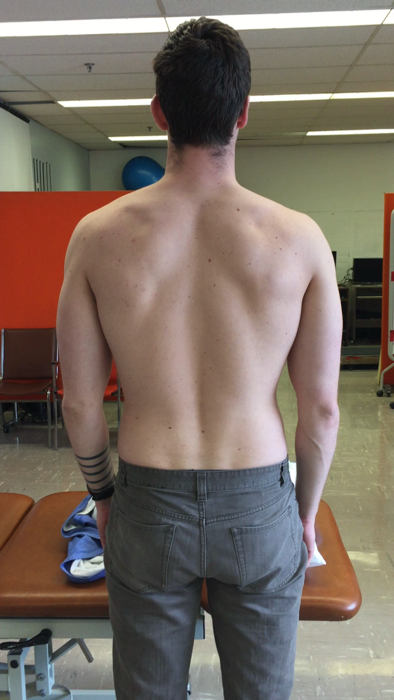Lift Small to Get Big: Training Scapular Stabilizers to Help Your Heavy Lifts
Today is day one of the Complete Shoulder & Hip workshop in Oslo, Norway, meaning Tony is dropping shoulder shenanigans all day long. Fittingly, today’s guest post is all about shoulder awesomeness from Caleb Smith, a Masters in Physiotherapy student at the University of Manitoba. Enjoy!!
*****
Like a lot of people, you probably haven’t given much thought to your subacromial space, I’m going to tell you why you should. This space houses some seriously important tendons and if they don’t have room to breathe, you’re going to pay for it. The biggest issue is the tendons in your rotator cuff – which you probably have heard about – if those tendons aren’t able to glide smoothly through that space, you’re scapula is going to let you know, and it won’t be pleasant.
Shoulder impingement is a common occurrence among the weight training as well as general population, up to 65% of shoulder complaints to physicians are due to impingement (Page, 2011) and 36% of weight training injuries occur in the shoulder (Kolber, Cheatham, Salamh & Hanney, 2014). Among the most common reason for these impingement injuries is a decrease in the subacromial space because people don’t take care of their scapular stabilizers. These guys help to provide optimal movement of your scapula during flexion and abduction. When these muscles aren’t looked after, it can cause a decrease in your subacromial space, up to 68% decrease during shoulder abduction to be exact (Page, 2011).
First, let’s talk about imbalances. There are tons when it comes to your scapular stabilizers, the first being the battle between your internal and external shoulder rotators. Your internal shoulder rotators are pectoralis major, minor, subscapularis, anterior deltoids, and heck, even latissimus dorsi is lend a hand – so to speak. All you have to externally rotate the shoulder is the supraspinatus, infraspinatus, and teres minor. This is like a tug-of-war between the Mr. Olympia contestants and a kindergarten class. Internal rotators win every time. This is a problem because when you ask lifters and athletes what their favorite exercises are, guaranteed you will hear an exhausting amount of “bench press”, because who doesn’t like a huge chest? Your subacromial space, that’s who. The more we work these internal rotators and neglect our external rotators, the more our humeral head is pulled anteriorly in the glenoid fossa. Sure you have great pecs, but when it hurts to reach overhead because there’s no room for infraspinatus to slide through the subacromial space, no one is impressed.
Our next imbalance is the battle of trapezius versus trapezius. The upper versus the lower, the House of Elevation versus the House of Depression. As expected the lower fibres of traps tend to lose this battle all the time. They are the Washington Generals of your back. It’s not a conscious movement, but our shoulders are always up by our ears, resulting in the upper fibres of traps working constantly. When upper fibres of traps are overpowering your lower fibres, the scapula will become rotated upwards, along with our previous internal external rotation battle, our subacromial space has diminished to a miniscule size and your rotator cuff tendons have been rubbed so raw you can barely lift your shoulder.
Next let’s discuss some neglected muscles. These guys lurk in the shadows, just waiting to be recruited to help stabilize the shoulder. The muscles in question include serratus anterior, rhomboid major, and the middle fibres of traps. All have an insertion point on the medial border of the scapula and will assist in normal scapulohumeral rhythm if given the chance. Problem is, these muscles fatigue easily and are difficult to target. With their help, the scapula will be better aligned, increasing the subacromial space, giving the tendons of biceps, infra and supraspinatus a chance to breathe and improving quality of movement.
Finally, but arguably the most important, we need to discuss posture. With most of the population working in an environment where they sit all day, all these previously mentioned muscles are set up for failure. I bet when I mentioned the word posture you sat up a little bit in your chair. People are conscious of good posture but can really only maintain it for a short period of time. If we are to improve the strength of our scapular stabilizers, we not only need good sitting posture, but good lifting posture. This means mastering the “pinch and tuck” and being able to hold that position for an entire lift.
Now that I have highlighted all these imbalances and ways we are letting down our shoulders, it’s time to pick up those little weights and get to work at putting ourselves at a biomechanical advantage. There are three exercises and one lifestyle modification that are a must if you are going to prevent leaving the gym with your arm dangling by your side:
- The “Pinch and Tuck”
This is the position we should all be living our lives in. Unfortunately, it’s hard to maintain. Start with a few second holds and try doing this before every lift, it provides a nice stable base for your entire. To perform you simply pinch your scapula together, gently though, you aren’t trying to crack a walnut back there. Then tuck your shoulder blades into your back pocket by slightly depressing the scapula, as shown in the video.
2) Prone T’s and Y’s
Start with your pinch and tuck, then perform shoulder extension with thumbs up to bias middle fibres traps, thumbs down to get rhomboids, and overhead to get at you lower fibres traps.
3) Scapular push-up
Begin in your standard pushup position, but instead of bringing yourself down to do a push up, pretend you’re pushing the floor away and protract your scapula as much as you can. To make this really hard, add some resistance with a band.
4) Sidelying external rotation
This is a very technical exercise and requires optimal scapular positioning to do it correctly. Ensure you set your scapula with the pinch and tuck, then perform shoulder external rotation. If you can do the exercise with more than a 5 pound weight, you are not recruiting the right muscles.
If you can incorporate these exercises into your daily routine and attempt to maintain the appropriate scapular position, I can guarantee you will be well on your way to happy shoulders. Happy shoulders means bigger lifts and less injury, and this is ultimately what we all want. So take care of your shoulders everyone, it’s an amazing joint and should be treated well. Happy lifting!
References
Kolber, M., Cheatham, S., Salamh, P., Hanney, W. (2014). Characteristics of shoulder impingement in the recreational weight-training population. Journal of Strength and Conditioning Research. 28(4), p. 1081-1089
Page, P. (2011). Shoulder muscle imbalance and subacromial impingement syndrome in overhead athletes. International Journal of Sports Physical Therapy. 6(1). P.51-58
About the Author
Caleb Smith is a Masters of Physiotherapy student that will be graduating in October from the University of Manitoba. He obtained his 4 year Bachelor of Science, majoring in exercise science from the University of Winnipeg where he spent two seasons as a pitcher playing college baseball. Caleb has a special interest in orthopedic manual therapy as well as exercise rehabilitation.

